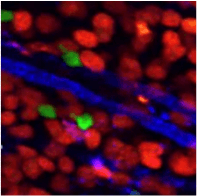Multiphoton microscopy records how metastasizing tumor cells move through the body
Radboud University Medical Center (Nijmegen, Netherlands) cell biologist Bettina Weigelin used multiphoton microscopy to record how metastasizing tumor cells move through the body and how immune cells hunt them down. She was also able to record the effect of different forms of immune therapy on cancer.
Using a multiphoton laser scanning microscope, Weigelin showed that the invasion of tumor cells into healthy tissue is not random. The cells crawl through cavities along blood vessels, between muscle tissues, or along nerve bundles. In fact, they choose the path of least resistance. This also means that the tumor does not damage the anatomy of healthy tissue.
The body is not completely defenseless against migrating tumor cells. The natural immune system has the capacity to attack cancer cells. In some cases, the body can in this way repel and destroy the tumor cells, but in many cases, the tumor cells will multiply to the point where the immune system cannot catch up. This creates a kind of arms race between tumor cells and immune cells. The immune cells engage their entire arsenal to eradicate the tumor cells. In turn, the tumor cells are doing their best to disarm the immune cells and to make themselves invisible.
In their pursuit of the tumor cells, immune cells also appear to choose the established pathways in the body. Using artificial connective tissue in the laboratory, Weigelin observed the interaction between tumor cells and a particular type of immune cells—so-called cytological T-lymphocytes (CTLs). She discovered that a repeated attack of CTLs is capable of killing immune-resistant cancer cells. She found this same effect in the living tissue of mice. The extent to which cancer cells were killed was the highest in regions where the concentration of CTLs was the highest.It is possible to boost the natural immune system against cancer with the help of immunotherapy. One way to do that is by extracting CTL cells from the patient’s body, multiplying them in the laboratory, and then to administer them again to the patient. This massive invasion of CTLs goes after the tumor cells that can no longer offer resistance to these superior numbers. The images made by Weigelin demonstrate that not only the number of active CTLs determines the success of the attack, but also the degree to which these immune cells can penetrate a tumor, and the longer life span they have subsequently.
Even though therapy using reinforced CTLs is effective, tumor cells may still become resistant to this control method. Fortunately, there are more options. Another form of immunotherapy uses monoclonal antibodies. These are signal substances that adhere to the cancer cells, allowing the immune system to recognize these cells more readily and remove them more quickly. However, tumor cells may also resist this form of treatment. Weigelin discovered in experiments in mice that when both forms of immunotherapy are combined, tumor cells eventually succumb. In tumors that were treated with antibodies, the CTLs survived longer, were able to bind better to the tumor cells, and remained active longer in their attacks on tumor cells. This greatly improved the inhibition of tumor growth.
For more information, please visit www.radboudumc.nl/en.

